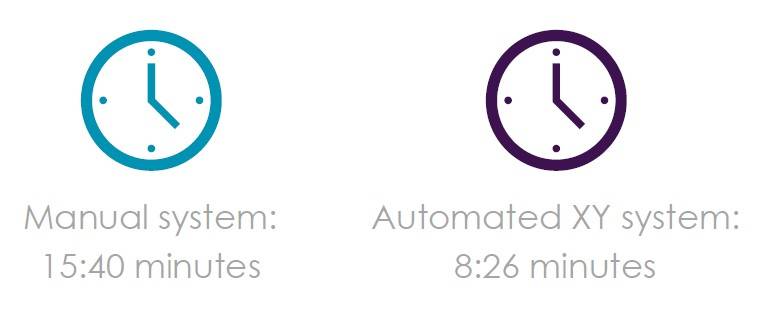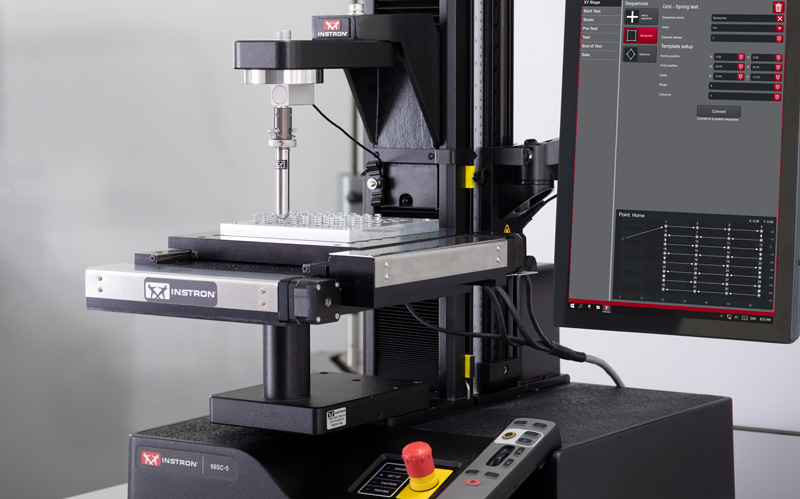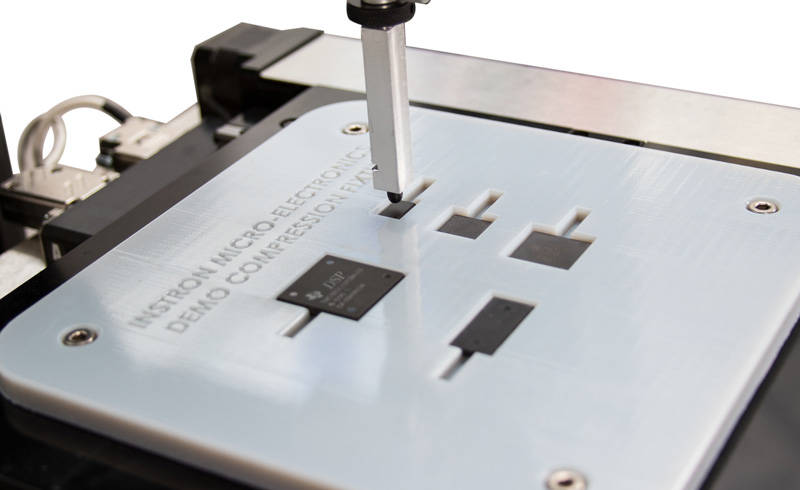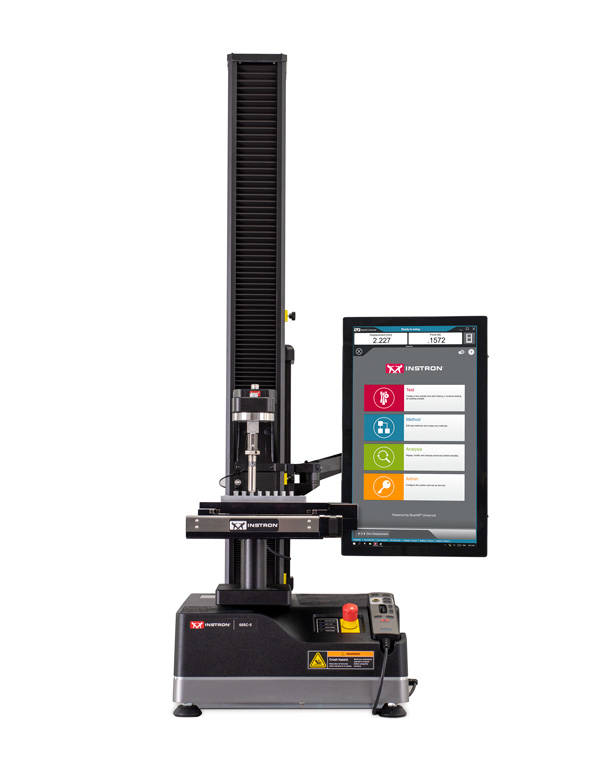Top Benefits of Semi-Automation for Materials Testing
Companies look towards automation to implement certain improvements in their business, including cost reduction and a safer and more efficient work environment. Automation can be implemented in many processes, from the production line to test labs. Fully automated materials testing systems are available to test hundreds of specimens without operator interference, even running overnight. These systems, however, aren’t necessarily the right solution for all test labs. Many labs don’t have the testing volume to make a reasonable return on investment of a fully automated system. Or instead of testing material coupons typical of an automated system, they may be performing component testing. For those customers, a semi-automated testing system may be a more suitable option for both their application and budget.
The addition of a semi-automated XY stage to a testing system brings several benefits to the lab:
- Increased throughput reduces the overall test time
- Greater efficiency allows operators to make better use of their time
- Increased repeatability results from more consistent test set up
- Increased safety and ergonomics for operators
Throughput
Throughput is one of the most important metrics in a test lab. The data generated by the lab is important to the overall success of the company; the results may be used in product development projects or to check product quality as it comes off the production line. Delays in testing may impact critical company targets, such as time-to-market for a new product or shipment deadlines.
The amount of time it takes to complete an actual test is fixed, whether the system is automated or manual. Test time is often regulated by international standards such as ISO, ASTM, and EN standards, or by company test procedures. The part of the process that can significantly increase the overall test time are the actions that occur between each test. The tested specimen must first be removed, making sure no remnants are left behind. Then the operator has to carefully set up the next specimen, making sure it is properly positioned and aligned. This takes time, which can vary greatly depending on the complexity of the test and the user’s experience. These are the areas – the time between tests - where a semi-automated system can greatly contribute to lab throughput.
One example of how an XY stage can benefit throughput is to look at data from benchmark testing that was performed on springs used in a surgical tool. Fifty specimens were run manually, which took nearly 16 minutes. The operator ran the tests one immediately after another, with no breaks or distractions. In reality, an operator who is manually running tests has regular interruptions, such as meetings, breaks, or conversations with colleagues, where testing is paused.

Those same fifty tests run using the semi-automated XY system took about 8.5 minutes. The XY system made it possible to test 46% more specimens in the same amount of time. This extra time may make the difference when it comes to time-to-market, hitting engineering project milestones, or releasing a product for shipment.

Customers using an XY system can maximize throughput even further by having multiple test fixtures available. While one batch of specimens is undergoing testing, the operator can prepare the next batch by setting all the specimens to be tested into the fixture. This minimizes downtime between tests, as the operator can quickly set up a new sample on the XY system and press start. Testing backlogs can be worked through more quickly, providing faster turnaround on data that is needed for R&D projects and on production lines.
Efficiency
While the XY stage helps increase lab throughput, it simultaneously improves efficiency by freeing up a significant amount of the operator’s time. The use of automation means the operator no longer needs to stand by the system while tests are run. They are free to walk away from the system and perform other value-added tasks, such as data analysis, completion of test reports, or measuring and preparing the next batch of specimens for testing.
The benchmark data from the spring tests shows that, in addition to increasing lab throughput by 46% over the course of an 8 hour shift, the operator will gain 3.5 hours of time back that would otherwise be spent in front of the system manually running tests. This 3.5 hours is time that can be used more efficiently.
Repeatability
There are many factors that impact repeatability. Specimen placement is important: if the specimen is not centered properly or is at an angle compared with the loading line, this will introduce variation into the results. While there are tools available to help with proper specimen alignment, this still relies on operator experience, and time and care still must be taken to set up a specimen. The XY stage is able to position test components or specimens with greater repeatability.

The operator’s influence on test results when specimens are inserted and aligned manually can be especially noticeable when you have multiple operators, with varying levels of experience, running tests on multiple systems or even across multiple labs. This is compounded when testing multiple points on small components. The integrated chips shown in the photo above are very small. Ensuring that these parts are tested in the center and at the same 4 points around the edge is challenging when setting the specimens up manually. An XY system with a well-designed fixture addresses the challenges around specimen placement and consistency of test locations. An XY stage provides repeatable test locations from sample to sample, ensuring that the data being generated is comparable.
Safety
OSHA estimates that companies in the U.S. pay $1 billion in direct worker compensation per week. This doesn’t include other costs related to disruptions to the lab. If an operator is out on medical leave, the lab’s throughput will likely be lower due to reduced staff. If the injured operator is the only one with knowledge on how to run a particular system or test, that loss of expertise will affect the lab’s ability to meet their customers’ requirements. Also, accidents in the lab often negatively impact user confidence when operating the equipment.
The reduced need for operator interaction when using an XY system results in increased safety, as the operator’s hands are rarely in the test space. It also offers better ergonomics as it removes the repetitive motion that is required when manually loading specimens.
Because the XY system removes some of the testing challenges around specimen alignment and test points, operators with less experience can be trained more quickly, will find the system easier to use, and will be more confident running the system. This lessens disruption in the lab.
Summary
Semi-automated systems such as the XY stage, can provide many benefits – throughput, efficiency, repeatability, and safety – to labs where a fully automated system isn't the best fit. The XY stage allows testing labs to implement automation on a smaller scale that is well suited for a range of applications, including medical devices, such as vials and syringes, and electronic devices and components.
The Automated XY Stage Testing System can perform motorized compression and tension testing of devices including medical equipment, electronics, and more.
Learn More
Product Manager
